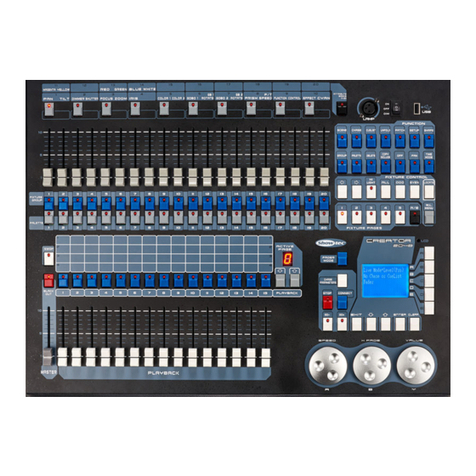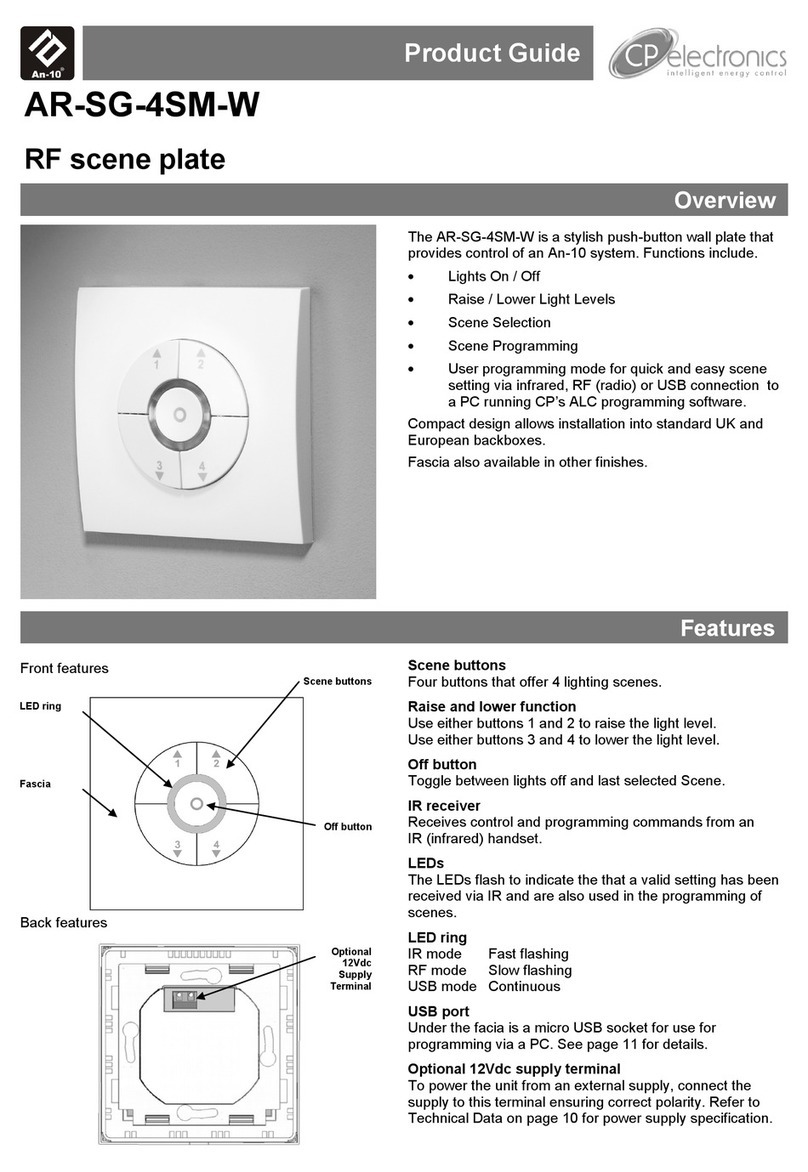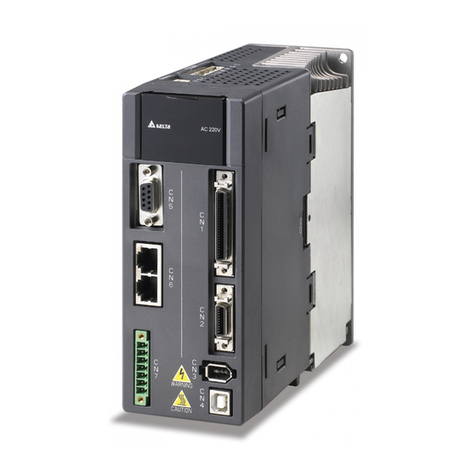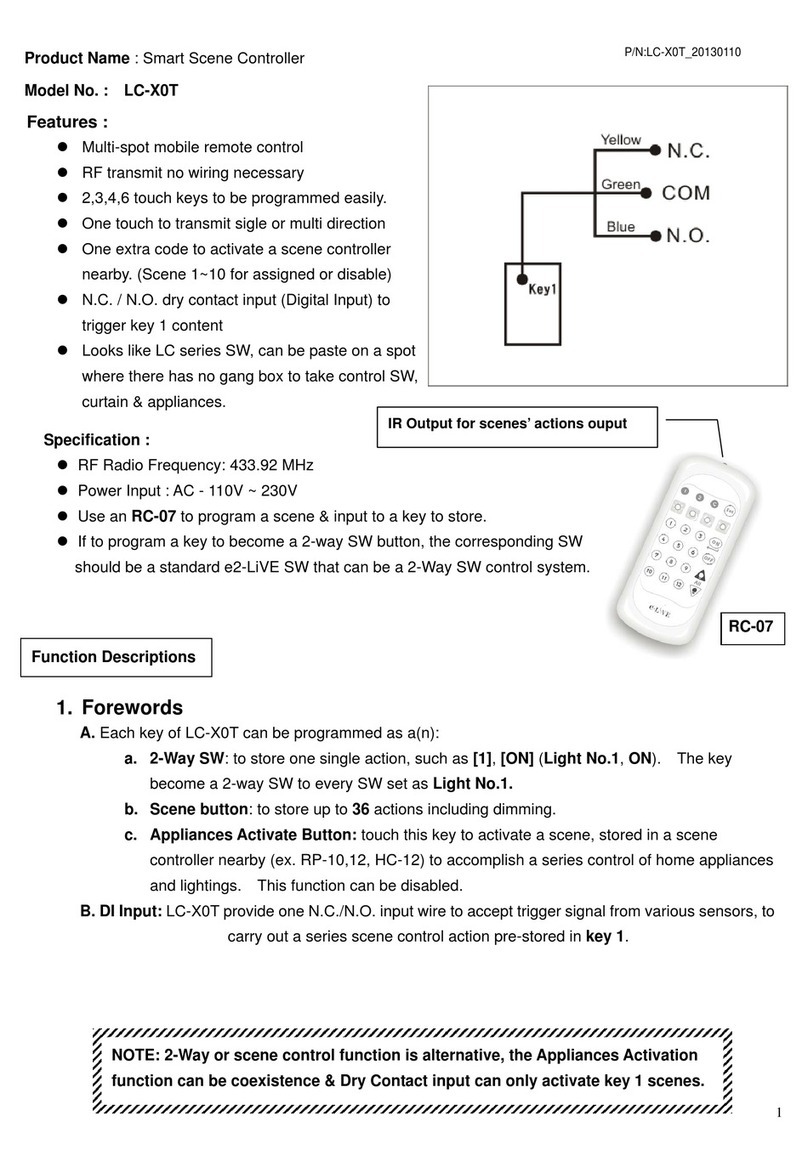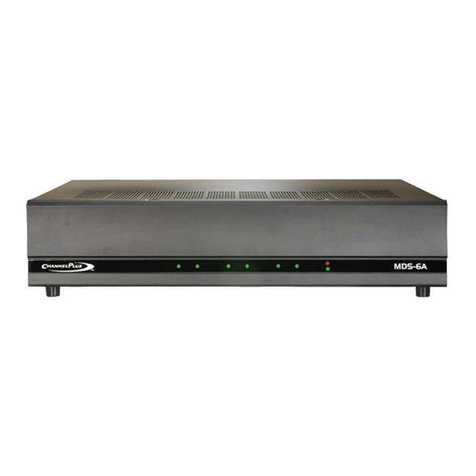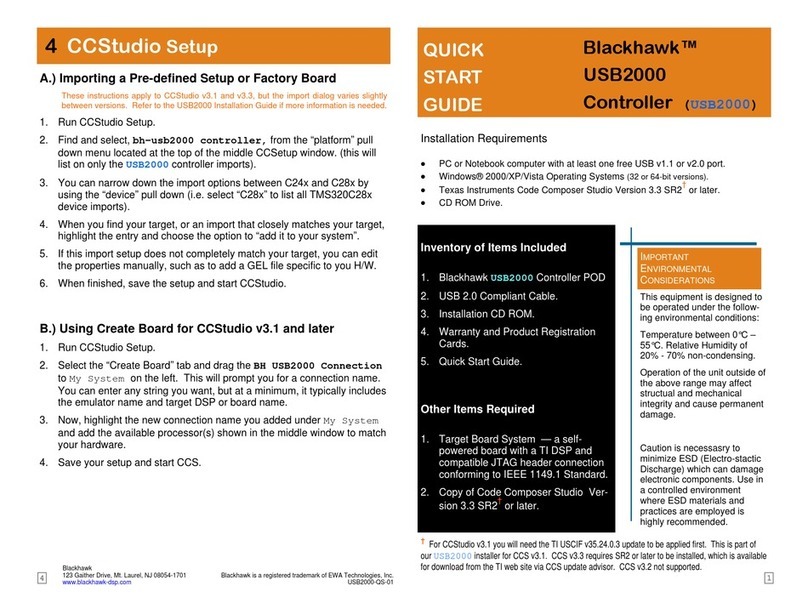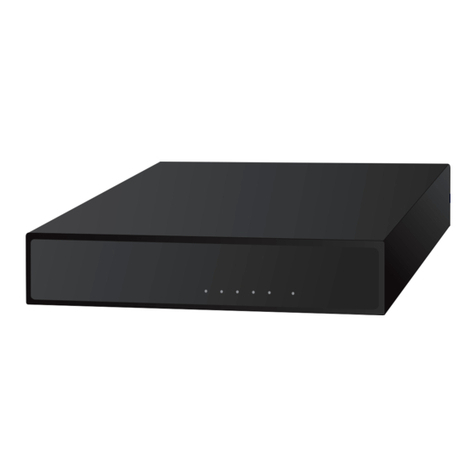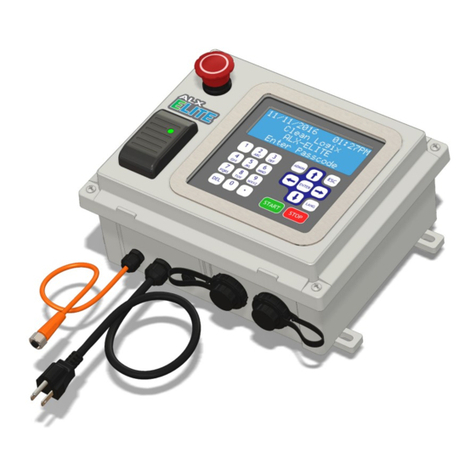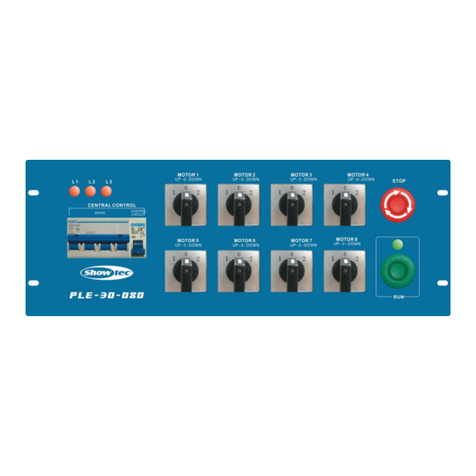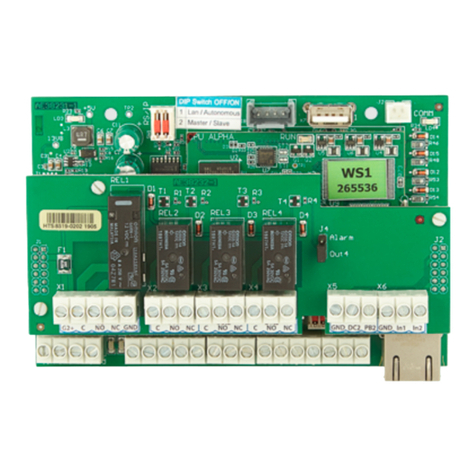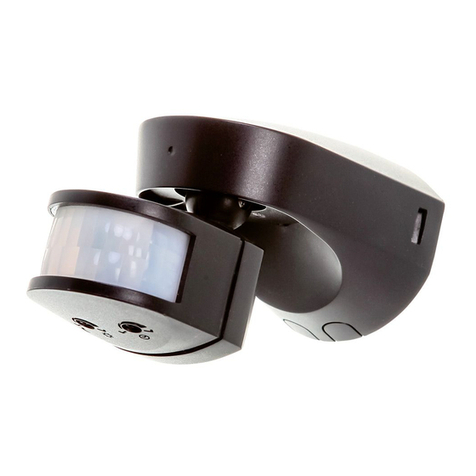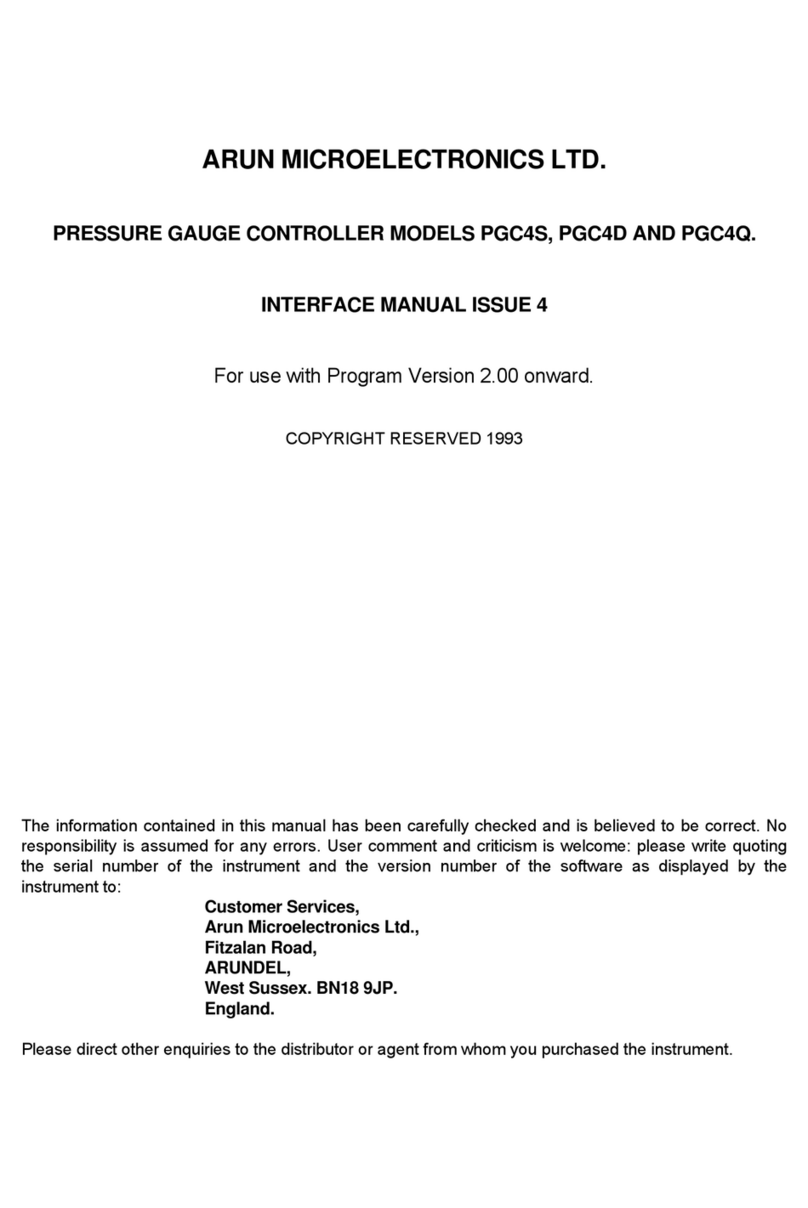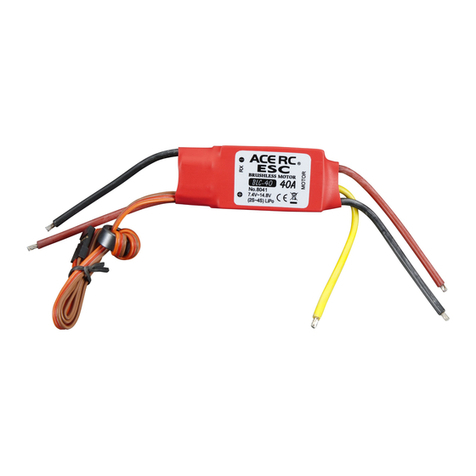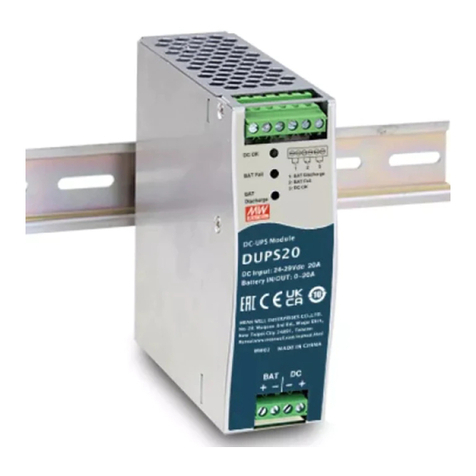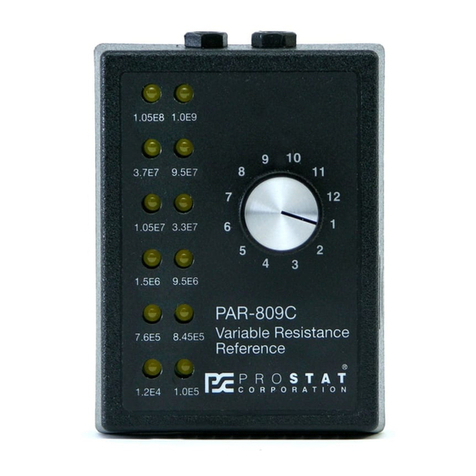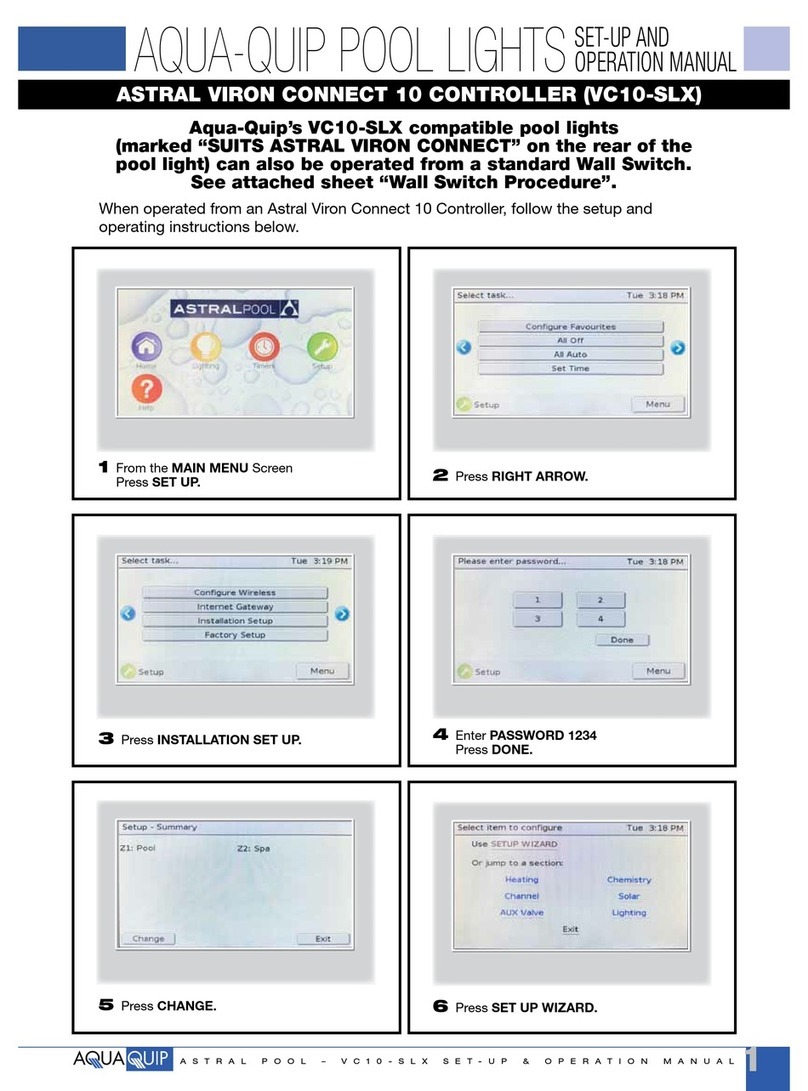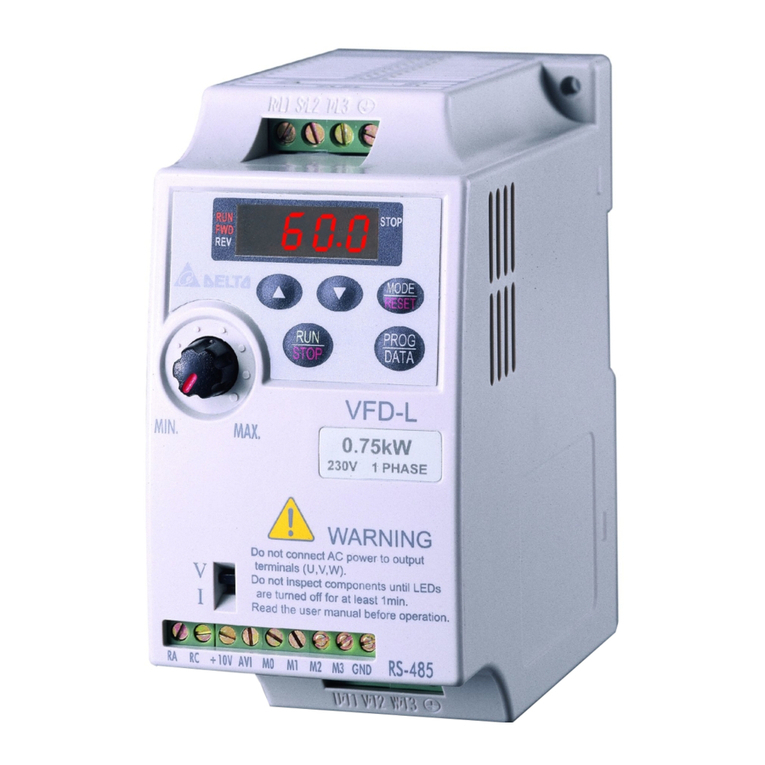Gaspar Xicoy LGC 13C User manual

-1-
Welcome!
Congratulations on the purchase of your new landing gear controller. Xicoy are
dedicated to the design and production of electronic controllers to the highest
standards of quality and reliability to bring you the customer the very latest next
generation designs.
Features
-Direct control of 3 motors in bidirectional and regulated mode up to 2,5 A.
-Control of electric brake, full proportional, lineal and adjustable pulsed mode.
-3 servo outputs for the control of the doors, endpoints programmable
-Steering servo processor. Programmable position of servo arm in retracted mode,
programmable center, sense of movement and gain on extended position.
-Single or dual channel mode.
-Programmable delay for extension and retraction of all gears independently.
-Easy programming trough a LCD display.
-Small size and lightweight.
Installation
Thanks the small size and lightweight of the unit, it can be placed in any place on the
model. We recommend a place where the wiring to the gears be the shorter as possible
to have a clean installation.
Electrical connections
Picture 1
Motor connections
Connect the 3 motor leads to the sockets in the unit. Please note that are labeled “Nose
gear”, “Left Gear”, “Right Gear”. Assure you connect the correct gear lead to correct
output in order that later during programming, the delays are applied to correct retract.

-2-
The polarity of the connection lead is marked on the label of the unit. In the case of
using reversed gears, the connector should be connected backwards to reverse the
operation of the motors.
Brake connections
Connect the leads from
brakes on the sockets
labeled “Brake”. Polarity and
position are not important
on the brakes.
You can use good quality JR
extension leads for the
motors and brake leads if
necessary.
Battery connection
Battery should be connected on the yellow MPX connector. Double check the correct
polarity before connecting the battery on the unit, a reversed battery connection will
destroy the unit, often the damage is beyond repair.
Output for the door servos
Connect the 3 servos to the outputs on the unit. You can connect more than one servo
to each output using a “Y” lead.
Output to the steering servo
Connect the steering servo to “Steer Out” if used.
Radio inputs:
You can choose to use a single channel to control the gear and brake, or separated
channels. Gear input channel should be always connected for operation, brake channel
and steering input channel are optional.
Power supply considerations: PLEASE READ!
This controller can receive up to 3 different power sources. In order to prevent
malfunctions in your system you should know that:
The main battery should be between 6,6 to 9,9V. Recommended battery is a Lipo of
7,4V. Please double check the polarity before connecting it. The damage caused by
polarity reversal is not covered by warranty!!!
Picture 2

-3-
This battery powers the motors and the brakes. The controller have a internal switch
operated by the
Gear Input
power. It is not necessary to disconnect this battery between
uses, but it is recommended to disconnect it after the flying session. There is a minimal
power drawn from this battery when the unit is switched off that can drain a battery in a
2 month period.
In the case you use battery regulators
a) The steering servo is powered by same supply as on the steering input (
Steer In
). So,
for example, if the steering input comes from a battery regulator (powerBox, etc) at
6V and the
Gear In
channel comes directly from the receiver powered at 5V, the
steering servo will be powered at 6V.
b) The outputs to the servos for the doors are powered from the
Gear Input
socket. If
you connect directly the gear input to a low power source (for example, directly to
the receiver when the receiver is powered by a low power, 5V regulator) the current
draw by the servos of the doors could be excessive, causing the receiver to switch
off.
c) The power input pin of the
Gear
and
Brake
inputs are internally connected together.
This could cause a malfunction by connecting different voltages together. For
example, if you connect the
Gear Input
directly to the receiver that is powered at 5V
and the
brake input
to a battery regulator that supply 6V, then the 6V supply will
flow trough the unit to the receiver, being no longer powered at 5V by a
independent regulator. In this case, it is necessary to cut the central wire (red) on the
lead from
Gear In
to the receiver to prevent the voltage present at
Brake In
to reach
the receiver. The controller and the door servos will be powered by the power
arriving to the
brake input
.
All negative (ground) connections are connected together inside the unit. Always fully
disconnect the batteries (both poles) from the installation before charging, as current
can flow trough the unit from one battery to the other during charge, damaging the
installation.
Please contact to Xicoy Electronica for advice on particular installations.
SETUP
Once you have installed the controller in your model, you can adjust the radio, outputs,
delays and steering servo.

-4-
Setup can be done trough a data terminal or trough a pushbutton and LED light. Full
functions are only available if programmed trough the data terminal.
In both cases, first of all you should decide if you will use one or two channels for
control, and then setup your transmitter accordingly. Check with a servo first that the
transmitter is operating as it should and to identify the RX channels used.
Double channel operation. The
Gear In
input control the retract operation and the
Brake
input control the brake.
Single channel operation: The
Gear In
input control both the gear and the brake.
The operation similar to a turbine engine control where raising the trim enable the
engine to run and the stick throw regulate the engine power. In this case, first the
gear will be operated and then the brake. For example, you can setup a channel that
from –100% to –75% activate the gear and from –75% to +100% regulate the brake
power.
The following setup procedure assumes the use of a Xicoy data terminal, please jump to
the “Manual Setup” section for the pushbutton and Led setup procedure.
Setup using a data terminal
Connect the data terminal (Same model as used by Xicoy V10 ecus) on the socket at left
side of
Gear In
input.
You can navigate trough the different menus by the buttons on the left side of the box,
and values are changed using the + and –buttons on the right side.
First screen displayed show the status (gear up, gear down, etc), the battery voltage,
power of the brake, and, during motor operation, the amperage to each of the motors.
Second screen display the RC signals measured from the receiver. You can check that
the RX connection is working and the measured values change when the transmitter
controls are operated. Standard RC signal go from 1000 to 2000uS, 1000us typically is
displayed on RC transmitters as –100% 1500uS 0% and 2000uS as +100%. Due at display
space the numbers are divided by 10, so a measured signal of 1400uS is displayed as
“140”. You can check that, when operating the transmitter, the reading change
accordingly.
On third screen you can scroll trough the different programming sections. Select the
area you want to program by pressing the “+” button.

-5-
Radio Setup
On this section you can program the radio inputs to mach your transmitter and setup
the brake power.
First screen is the Gear Up position (Picture 3):
Set the transmitter switch or slider of the gear
channel in the position you wish that the gear be
in retracted position. Current reading is displayed
on the right side of the screen. Once the TX is set,
press the “+” button. The controller will store
the current signal received as “gear up” command.
Next screen is the Gear Down position:
Set the transmitter switch or slider of the gear channel in the position you wish that the
gear be in extended position. Once the TX set, press the “+” button. The controller will
store the current signal received as “gear down” command.
Next screen is the Brake OFF position:
Set the transmitter switch or slider of the brake channel (or on the gear channel if you
use the single channel option) in the position you
wish that the brake be unpowered. Press the “+”
button.
The controller will store the current
signal received as “Brake OFF”
command (Picture 4). Note that if in this step the controller does not detect a valid
signal in the brake input, then it will assume a single channel operation mode, To enable
double channel, this step should be repeated once the brake channel is connected to a
valid RC signal source.
Last radio screen is the Brake Maximum position.
Set the transmitter switch or slider of the brake channel (or on the gear channel if you
use the single channel option) in the position you wish that the brake be at maximum
power. Press the “+” button. The controller will store the current signal received as
“Brake 100%” command”.
This completes the radio setup for the gear and brake channels. But two more adjust
options are offered in this section:
Picture 3
Picture 4

-6-
1. Brake limiter: The limiter usually is set at 100% and the brake power is adjusted
trough the TX, but in the case that you need to limit the maxim brake power, you
can decrease this setting to reduce the power applied to brakes.
2. Brake pulse ratio: The power to the brakes could be pulsed in order to produce a
“ABS like” operation, brake power is pulsed at fast rate to avoid to create “flats” on
the tires on hard braking. It is possible to adjust the brake pulses in different values
to change the ratio between the “high power” and “low power” pulse depending on
wheel diameter and model weight.
Servo sequencer setup
The unit provides 3 independent outputs for to control the servo operated doors. All 3
outputs are adjusted by the same procedure, so the setup of only one output is
described
It is possible to define 3 different positions for each output:
Gear Up position: The position you wish that the servo be driven when the gear is
retracted. Typically is a closed door.
Gear Down position: The position you wish that the servo be driven when the gear is
extended. Depending on model type, could be a opened or closed door.
Motor ON position: The position of the doors when the retracts are moving, typically
open.
The setup of the position in each phase is easily done by the help of the steering input
channel. In the case you don’t use this channel on your installation you should
temporarily connect a RC signal from the rx or from a servo tester in order to operate
the servos manually to the desired position.
It is recommended to connect only the servo being adjusted to avoid the other servos to
move uncontrolled during the setup.
First screen is the “Servo 1 Gear Up
position”. (Picture 5)
When this screen is displayed, the
servo1 OUT
will deliver the same
signal as arriving to the Steering
input, so that you can move the servo
Picture 5

-7-
directly trough the rudder stick on your TX. Set the servo at the position you want that it
to be when the gear is retracted, and press the “+” button. The current position will be
stored in the permanent memory of the controller. In the case you don’t want to modify
this position to keep the old stored value, simply change of screen by the menu buttons,
the settings are only changed on the permanent memory when the “+” button is
pressed.
Next screen is the “Servo 1 Gear Down
position”. Operate the servo trough
the TX to the position you want that it
to be when the gear is extended, and
press the “+” button.
The position could be the same as the
“gear up” position if you want a CLOSED-OPENED-CLOSED sequence.
Last screen is the “Servo 1 Motor On
position” (Picture 7). Again, operate
the servo trough the TX to the
position you want that it to be when
the gear is in movement, and press
the “+” button to store the setting.
Usually is the same position as the “gear down” position in the OPENED-CLOSED
sequence, but also it allow programming an over travel, the door opens more during
gear operation to give extra clearance to the wheel and legs, but return to “scale”
position when the gear is fully extended.
Servo 2 and Servo 3 are programmed same way.
Last screen is the “Servo switch off
time:” (Picture 8) To prevent the
possibility of a servo to be overloaded
and burned due at being jammed, a
protection function is added that allow
to release the servo force after some
seconds (programmable by this
parameter).
After the movement of retracts is finished, the servo signal is switched off, that cause the
servo to act as “unpowered”. The servo position is refreshed each 15 seconds to
compensate the small movement of the servo (if any) during these 15s to keep the door
Picture 6
Picture 7
Picture 8

-8-
in to commanded position, assuming that there is not a considerable force acting on the
servo during the switch off period. In the case you want that the servo be active all the
time, set this parameter to zero.
Correct operation of this feature implies a servo that become “soft” when no signal
received. All analog servos act like this, but some digital servos hold the position when
no signal is received. If you plan to use digital servos on the doors and to use the switch
off feature, check first if your servo is compatible, or use a analog servo. The Hitech and
Multiplex digital servos we have tested are not suitable, but JR 8511 is.
Motor delay
To replicate the operation of full size landing gears, it is possible to set a programmable
delay for each motor operation.
First screen on this section is the delay in seconds of the main, left gear when Gear Up is
selected. “Gear Up Delay Main Left”is displayed on the screen. Use the +/- buttons to
set the time you want the controller wait before the left main motor is operated since
the Gear Up command is selected.
Second screen is the delay time on the same gear (main left) motor operation when
“gear down” is selected.
Next screens adjust same delays for right mains and nose gear. Please note that you can
use this function to insert a delay from door operation to gear operation by
programming same delay on all 3 motors.
Steering servo processor
The steering servo is controlled trough the unit to assure that the nose wheel is centered
to a defined position during retraction and does not move while the gear is retracted.
Over this function, a signal processor is added that allow modifying the center, gain and
direction of operation of the steering when the gear is down. Thus, it is possible to take
the steering input signal from the same channel as the rudder, despite the different
centering, sense of movement and travel between these two servos, saving one RC
channel.
Setup
Connect the Steering input to the desired RX channel for the steering (or troughs a “Y”
lead on the rudder channel).
If you use same signal as the rudder, first setup the rudder centering and travel. Once
you are satisfied with the rudder operation, connect the steering servo and proceed to
adjustment.

-9-
First adjustment is the position of the steering servo at retracted position. Using the
rudder channel of your TX, set the servo to the position you want it when the gear is
being retracted and stored. Press the “+” button to store the setting in the permanent
memory.
Next adjustment is the centering of the servo in deployed position. Double check that
the rudder is centered, and then using the + and –buttons center the steering servo.
Finally, check the steering travel and sense. A range of adjustment from –200% to
+200% is provided. Positive numbers mean same direction as rudder, negative numbers
mean reverse operation. A 100% setting give same travel and direction as the rudder
servo, -100% give same travel but reverse operation, 200% travel mean double travel
than rudder, 50% give half movement. Once you set the travel and sense, it is possible
that the centering need a new adjust, just go back to previous adjustment by the menu
buttons.
Motor adjust
This last section of adjustment allows adapting the unit to different motors. These
adjustments are not available in some of the units that are setup by motor
manufacturer.
First adjustment is “Motor Cut
Amperage”(Picture 9). Maximum
value is 2,5A.
This is the threshold amperage to detect that the motor have arrived at end of travel.
This is the most important parameter that should be set to the recommended value
from the motor manufacturer. It should not be changed unless you know exactly what
you are doing. A too high value could cause that the endpoint be undetected, burning
the motor, or that the gear train to be damaged by a excess of torque.
Next, it is the “Unload time”.
(Picture 10) When the gear
movement is finished, a short pulse
of reversed power is sent to the
motor to remove the tension stress
on the gears, bearings and
suspension.
Picture 9
Picture 10

-10-
Too low time will not unload the motor, causing high stress and wear; too long time can
move the slider out of “lock” position.
Last adjustable parameter is the “Maximum Motor time”. This is a security parameter
that will power down the motors after a certain operation time (programmable) to
prevent the case that the endpoint is undetected.
Last screen display a counter of operations to track the number of the cycles and
schedule maintenance.
Manual operation
Besides the operation in normal mode (controlled by the radio), there unit offers several
testing options to operate the gear in manual model.
Under “Manual mode” menus, you can deploy or retract the gear, with the possibility of
to stop and resume the movement in any point, plus operate each gear independently
up and down, with the possibility of to stop, reverse and resume the movement in any
point of the travel.
NOTE: When you leave the manual mode menus, the controller will return to a “RC
mode”, so the gear will move automatically to the currently command received from the
transmitter.
Switch On delay
There is some intelligence build in the controller to prevent unwanted gear operation
when switching on the receiver and power supply. At power up, the controller will wait
during 3 seconds, waiting for the receiver to boot and stabilize the outputs, ignoring any
glitches that it could generate during this time. After these 3 seconds, the controller will
begin to check the RC signal, but will wait to operate the gear until a change on RX
signal is received. Thus, if at “switch on” the gear is down, but the signal received from
the TX is “gear up”, the gear will keep down, it will be necessary to place the TX switch
to “gear down” and back to “gear up” to initiate the retraction.
Setup without the Data terminal
There is a LED indicator and a pushbutton to allow setup the unit without the data
terminal. In this case the options are considerably reduced from the full options
available using the data terminal.
Connect the RC channels you want to use (
Gear In
obligatory,
Brake In
and
Steering In
optional). Set the
Steering In
(Rudder channel) in the position you want that the
steering servo be placed during retraction and gear up position.

-11-
Leave the main battery disconnected to prevent accidental movement of motors.
Switch off the power. Press the button with the aid of a plastic rod (a pen, etc, but
nothing metallic that could damage the electronic board). While the button pressed,
switch on the power on the receiver.
When receiver powered, release the switch.
The blue LED will light intermittently, one short flash with a long pause between flashes.
Set your transmitter at the position you want the gear to be retracted.
Once the TX set, press the switch again. Hold it pressed until it lit continuously, this will
indicate that the command received from the TX as been stored as “Gear Up” command.
Release the button, the led will blink 2 short times followed by a long pause. Repeat the
procedure described above for to memorize the remaining radio commands:
1 blink Gear Up command
2 blinks Gear Down (extended) command
3 blinks Brake OFF. The unit will detect if signal present on Brake In, if not will
assume single channel mode.
4 blinks Brake maximum.
5 Blinks Steering servo retracted position.
NOTE: Executing this procedure will set all remaining adjustments to the factory
defaults, all delays, door servo positions, steering servo adjustments will be reset to
default. This procedure allow to use the controller in simple models without the need of
a data terminal.
Disposal
Electrical equipment marked with the cancelled waste bin symbol must not be
discarded in the standard household waste; instead it must be taken to a suitable
specialist disposal system.
In the countries of the EU (European Union) electrical equipment must not be discarded
via the normal domestic refuse system (WEEE - Waste of Electrical and Electronic
Equipment,directive 2002/96/EG). You can take unwanted equipment to your nearest
local authority waste collection point or recycling centre. There the equipment will be
disposed of correctly and at no cost to you.
By returning your unwanted equipment you can make an important contribution to the
protection of the environment.
Table of contents


